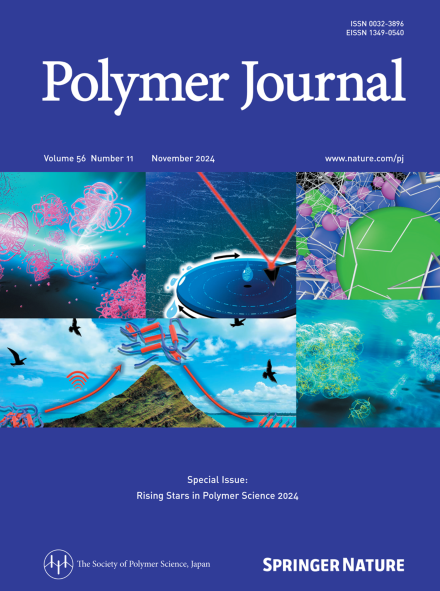Surface and interfacial aggregation states in thin films of a polystyrene/polyrotaxane blend
IF 2.3
4区 化学
Q3 POLYMER SCIENCE
引用次数: 0
Abstract
Polyrotaxane (PR) exhibits unique mechanical properties due to the ability of its cyclic molecules to move or slide along the axial chain. Thus, to design advanced polymer-based composite materials and organic devices, it is crucial to better understand the aggregation states at the surface and substrate interface in polymer films containing PR. Here, we report the depth profile of PR along the direction normal to the interface when it is mixed with polystyrene (PS). Neutron reflectivity and X-ray photoelectron spectroscopy revealed that PS and PR segregated at the surface and substrate interface, respectively, and that the extent of segregation depended on the length of PS. The surface enrichment of PS is driven by both energy and entropy, whereas the enrichment of PR at the substrate interface is energy driven. To design and fabricate advanced polymer-based multilayer devices and composite materials, it is crucial to gain a better understanding of the aggregation states at the surface and at interfaces with solid materials in polymer films. Here, we report the depth profile of polyrotaxane (PR) when mixed with polystyrene (PS), analyzed using X-ray photoelectron spectroscopy and neutron reflectivity. Our findings indicate that PS and PR segregated at the surface and the substrate interface, respectively, with the extent of segregation depending on the length of the PS chains.

聚苯乙烯/聚轮烷共混物薄膜的表面和界面聚集态
聚轮烷(PR)由于其环分子沿轴链移动或滑动的能力而表现出独特的力学性能。因此,为了设计先进的聚合物基复合材料和有机器件,更好地了解含有PR的聚合物膜在表面和衬底界面处的聚集状态是至关重要的。在这里,我们报告了PR与聚苯乙烯(PS)混合时沿界面垂直方向的深度分布。中子反射率和x射线光电子能谱分析表明,PS和PR分别在表面和衬底界面发生偏析,偏析程度取决于PS的长度。PS的表面富集是由能量和熵驱动的,而PR在衬底界面的富集是由能量驱动的。为了设计和制造先进的聚合物基多层器件和复合材料,更好地了解聚合物薄膜中表面和与固体材料界面的聚集态至关重要。本文报道了聚轮烷(PR)与聚苯乙烯(PS)混合时的深度分布,并利用x射线光电子能谱和中子反射率进行了分析。我们的研究结果表明,PS和PR分别在表面和底物界面分离,其分离程度取决于PS链的长度。
本文章由计算机程序翻译,如有差异,请以英文原文为准。
求助全文
约1分钟内获得全文
求助全文
来源期刊

Polymer Journal
化学-高分子科学
CiteScore
5.60
自引率
7.10%
发文量
131
审稿时长
2.5 months
期刊介绍:
Polymer Journal promotes research from all aspects of polymer science from anywhere in the world and aims to provide an integrated platform for scientific communication that assists the advancement of polymer science and related fields. The journal publishes Original Articles, Notes, Short Communications and Reviews.
Subject areas and topics of particular interest within the journal''s scope include, but are not limited to, those listed below:
Polymer synthesis and reactions
Polymer structures
Physical properties of polymers
Polymer surface and interfaces
Functional polymers
Supramolecular polymers
Self-assembled materials
Biopolymers and bio-related polymer materials
Polymer engineering.
 求助内容:
求助内容: 应助结果提醒方式:
应助结果提醒方式:


